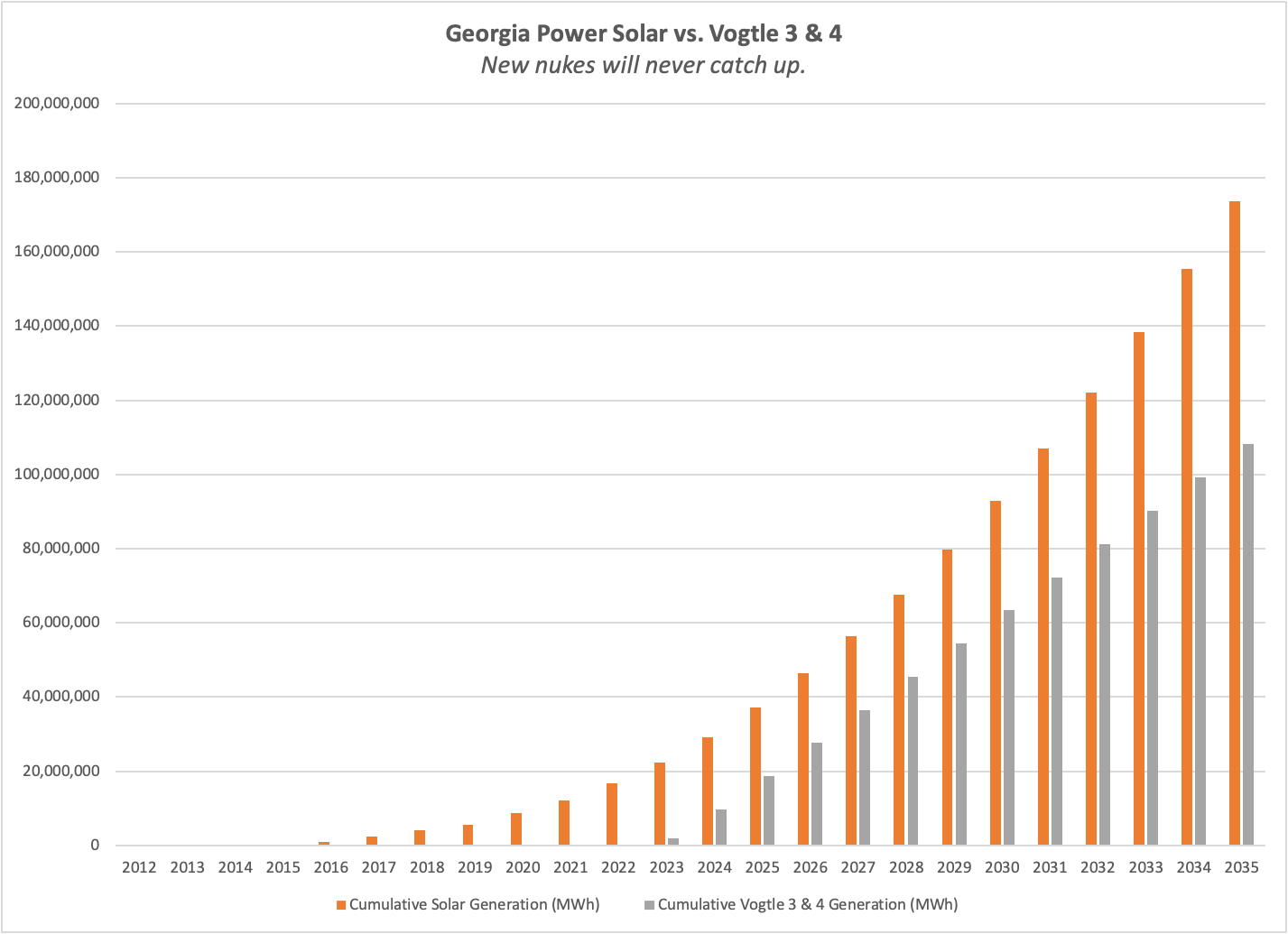During the time that the Vogtle nuclear units 3 & 4 have been under construction, more than 4,500 MW of solar has been built in the state of Georgia. That's double the peak CAPACITY (MW) that those nukes will (eventually) bring online -- and at 1/5 the cost. Of course, solar isn't a 24/7 resource. But let's examine the current and future GENERATION (MWh) from those resources.
Bryan Jacob | November 22, 2023 | Georgia, Nuclear, SolarSolar energy started to emerge in Georgia in 2012. Coincidentally, that was around the same time that Southern Company began construction on Plant Vogtle nuclear units 3 and 4.
Plant Vogtle Unit 3 became operational earlier this year and Unit 4 is expected to be online by Q1 of 2024. However, when the Georgia Public Service Commission (PSC) certified these units for construction back in 2009, they were expected to be completed in 2016 and 2017. The fact that they are seven years past due and more than double the original budget has been well documented.
Over that same period while Vogtle 3 & 4 have been under construction, 4,500 MW of solar capacity (MW) has been developed in Georgia and at just 1/5 the cost of those two Vogtle units. By comparison, Vogtle 3 & 4 will eventually provide 2,200 MW of capacity for Georgia.
Before you retort “But the sun doesn’t shine all the time” — I am well aware. That, too, has been explored rather extensively. I’ll refer you to this enlightening podcast by Volts: What? The sun isn’t always shining?!
It is indeed constructive to consider the amount of energy generated (MWh) from solar in addition to the overall capacity (MW) constructed. Although nuclear units generally produce power for more hours in a day than solar projects do, that is only true after construction is finished.
Those solar units have been already generating for years, with even more solar planned to come online in the coming years. Meanwhile, Vogtle 3 just started generating this year (with Vogtle 4 further delayed until 2024). It got me wondering: how long will it take those new nuclear units (operating 24 hours per day) to produce as much electricity as solar units have already produced and are expected to produce into the future?
Spoiler Alert: Vogtle 3 & 4 won’t catch up!
If Vogtle 3 & 4 had been completed on-time, the situation could have been different. Nuclear output would have had the lead after 2016 and it would have taken until 2032 before the expected cumulative solar output eclipsed nuclear.
But because of the multi-year delays in starting up Vogtle 3 & 4, solar has built up such a lead that the new nuclear units may never catch up. And since the plans in Georgia forecast continued solar buildout with no new nuclear plants currently planned — even with continuous operation, the cumulative output from those new nukes will never exceed the cumulative output from solar.
This graph shows the output for Georgia Power’s share of Vogtle 3 & 4 (45.7% = 1 GW) compared to the generation from solar projects supplying the Georgia Power system (3 GW now, and continuing to grow).

The closest the Vogtle 3 & 4 output comes is in 2025 when those units are fully dispatched and new solar buildout (already approved) is continuing but not yet operational. By 2026, the annual output of solar is expected to exceed the annual output of Vogtle 3 & 4; so from that point onward, the cumulative margin of victory for solar will only increase.
As clean energy advocates, SACE anticipates even further and faster expansion of solar as we approach 2030 and beyond. This is precisely what climate science indicates is necessary.